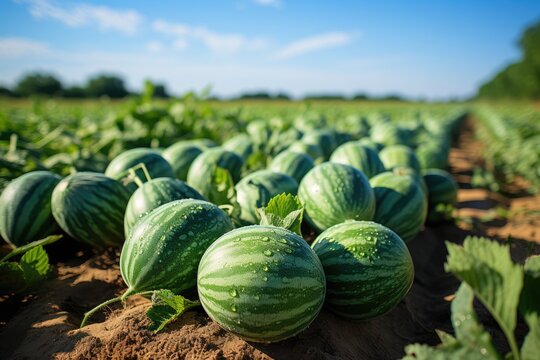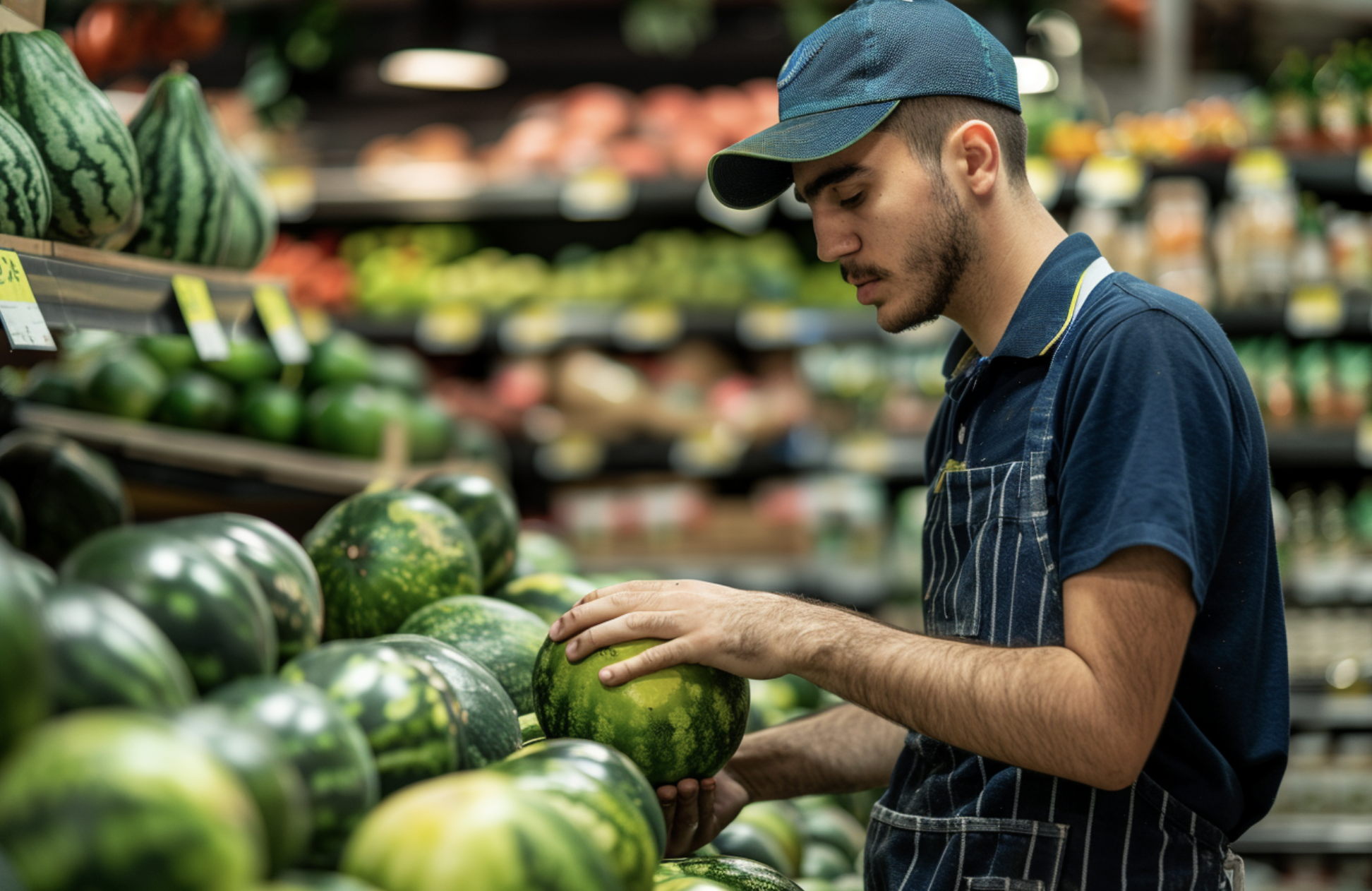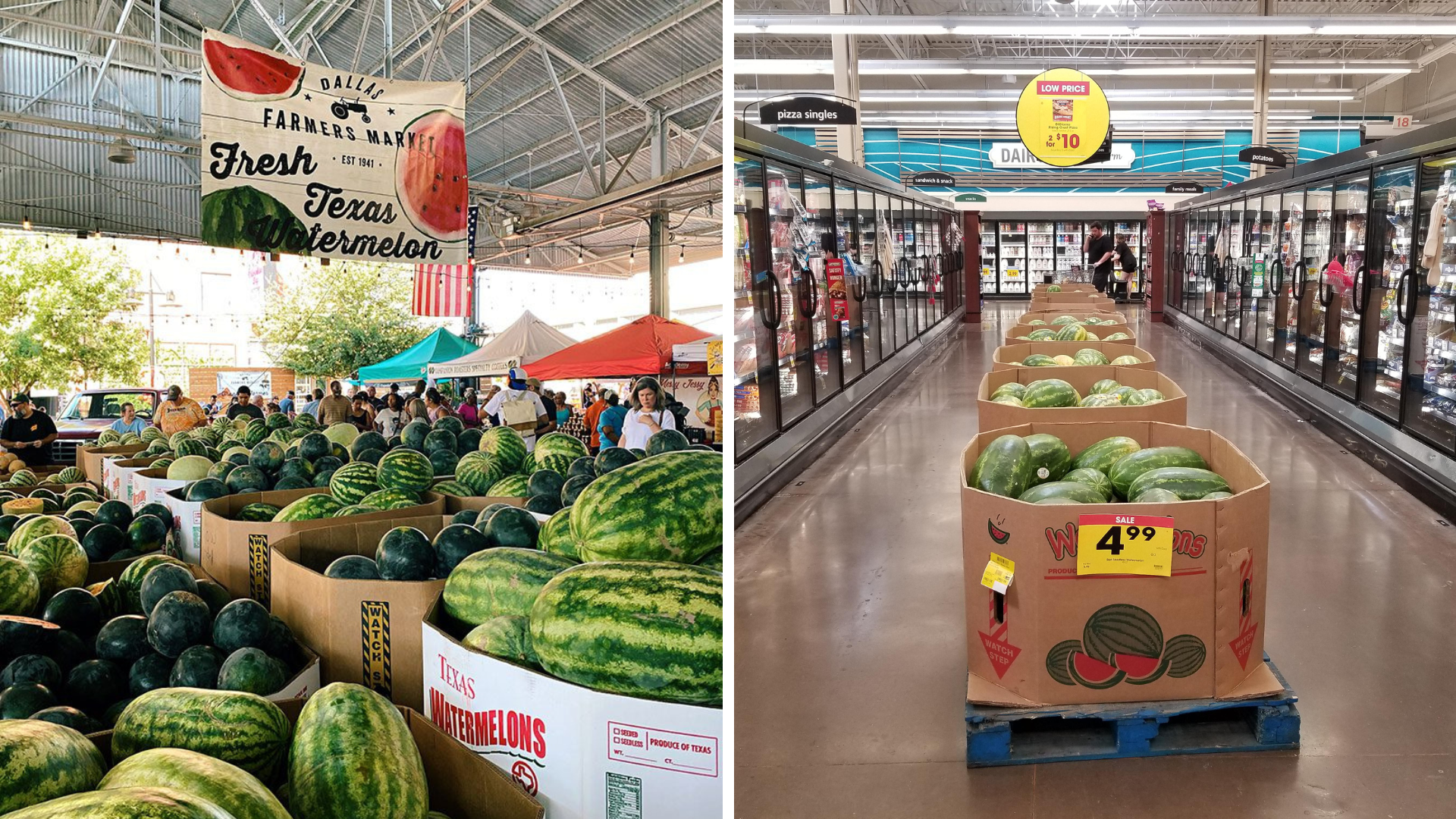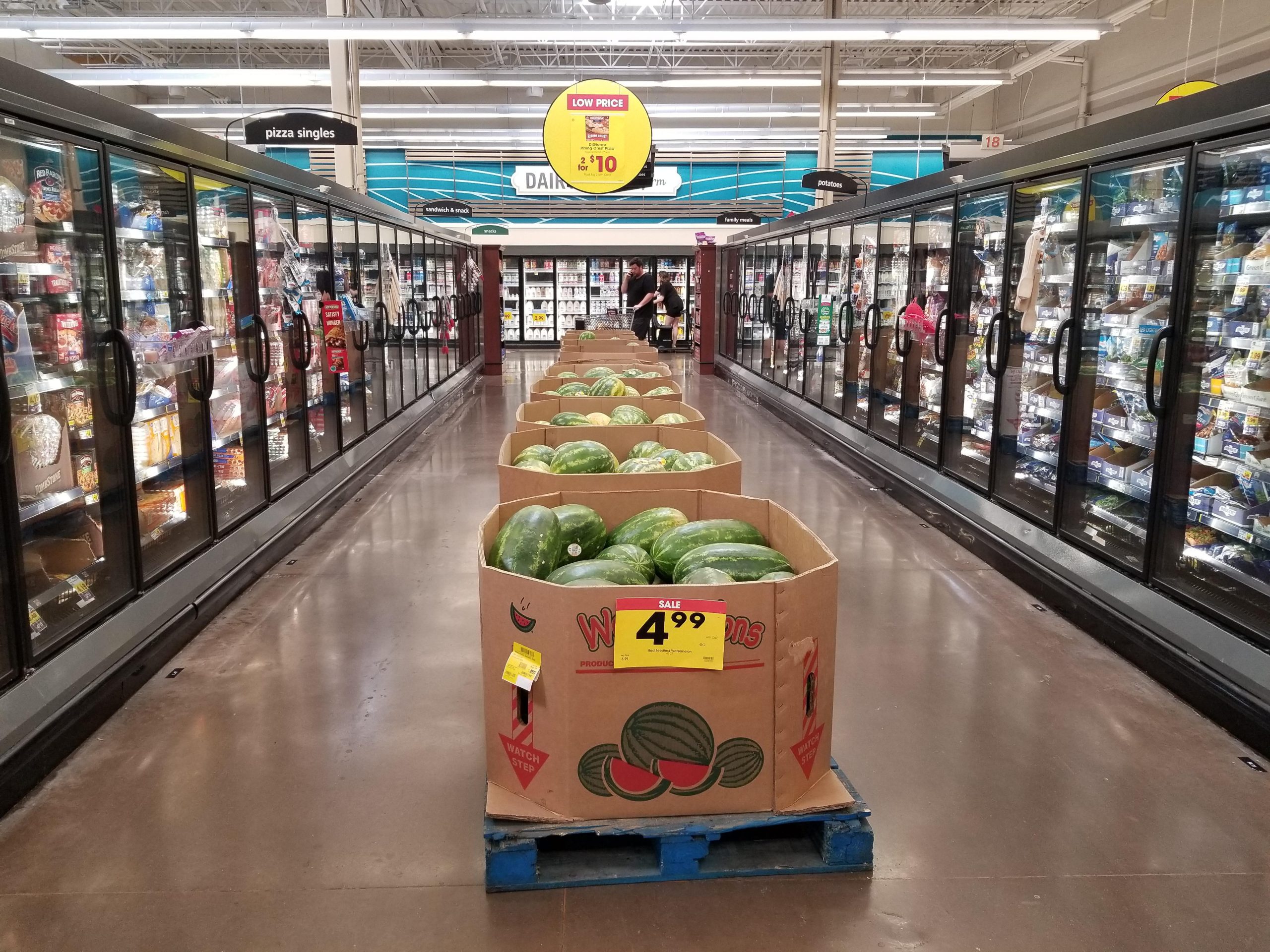Struggling to pick the perfect watermelon? You’re not alone.
It can be frustrating to get home, slice into your watermelon, and find it’s either underripe or past its prime. But what if there was a foolproof way to ensure you always choose a fresh, juicy watermelon?
Get ready to become a watermelon-picking pro with this ultimate guide!
We’ll reveal the secrets to selecting the best watermelons every single time so you can enjoy the sweet taste of summer without any disappointment.
From examining the shape and color to understanding the importance of the field spot, you’ll learn expert tips and tricks to make your watermelon-buying experience a breeze.
Say goodbye to watermelon guesswork and hello to guaranteed freshness with this comprehensive guide.
The Importance of Freshness in Watermelons

When it comes to fruits and vegetables, freshness is key. Fresh produce tastes better and retains more of its nutritional value.
This is particularly true for watermelons. Their freshness can significantly affect flavor, texture, and overall quality.
A fresh watermelon will have a crisp, juicy texture and a sweet, vibrant flavor.
In contrast, a past-its-prime watermelon often has a mushy texture and a bland, watered-down taste. The noticeable difference can greatly affect your enjoyment of this summertime favorite fruit.
In addition to taste and texture, freshness also influences the nutritional value of watermelons.
Fresh watermelons retain higher levels of essential vitamins and antioxidants, such as Vitamin C, Vitamin A, and lycopene. These nutrients support immune function, maintain healthy skin, and promote well-being.
However, these beneficial compounds degrade as watermelons age or are stored for extended periods.
Hence reducing the fruit’s nutritional profile. By choosing a fresh watermelon, you ensure you get the maximum health benefits this delicious fruit offers.
The freshness of watermelon also plays a role in its culinary versatility.
Fresh watermelon can be used in various dishes, from refreshing salads and salsas to thirst-quenching drinks and frozen treats.
Its crisp texture and sweet flavor add a burst of summer to any recipe.
How to Check the Freshness of Watermelon
1. Visual Cues: Your First Step in Choosing a Fresh Watermelon

Visual inspection is your first defense when selecting a fresh watermelon.
Before picking up a watermelon, a quick visual assessment can provide valuable clues about its quality and freshness. This method will allow you to narrow your choices and increase your chances of bringing home a deliciously fresh melon.
Start by examining the watermelon’s overall appearance, then focus on specific features that indicate freshness.
- One of the key visual indicators of a fresh watermelon is its color. Look for a watermelon with bright, uniform green skin. Avoid melons with yellowing or dull patches, as these may signify overripeness. The pattern on the watermelon’s skin can also provide insights into its growth conditions. Uniform stripes suggest that the watermelon received consistent nutrients and water during its development. On the other hand, random or light spots may indicate uneven ripening or poor growing conditions.
- Another crucial aspect to examine is the field spot. The field spot is where the watermelon rested on the ground while growing. A creamy, yellowish field spot is a sign of a ripe watermelon. In contrast, a white or green field spot suggests that the melon was harvested too early and may not have reached its full sweetness potential.
- Additionally, pay attention to the webbing on the watermelon’s surface. These brown, web-like scars indicate the frequency of pollination. Generally, more webbing correlates with a sweeter watermelon, reflecting greater sugar development during growth.
- Consider the watermelon’s symmetry and shape for a more advanced visual inspection. Asymmetrical watermelon is more likely to have experienced consistent growth conditions, resulting in even ripening. Irregular bumps or depressions may indicate internal issues or uneven growth.
- Look for any abnormalities, such as sunken spots or cracks, that could indicate disease or internal damage. Apply these visual inspection techniques in a store or market setting systematically.
- Avoid melons with excessive glossiness, as this can indicate underripeness. Similarly, steer clear of watermelons with a dull appearance, as they may be past their prime.
By focusing on the visual cues mentioned above, you’ll be well-equipped to choose a watermelon that is likely to be fresh, juicy, and ready to enjoy.
2. Tactile Inspection: A Hands-On Approach to Choosing Fresh Watermelon

While visual inspection is a great starting point, tactile inspection takes your watermelon selection skills to the next level.
By using your touch, you can gather additional information about a watermelon’s ripeness and quality.
Feeling the watermelon’s firmness, texture, and weight can provide valuable insights that visual cues alone may not reveal.
Incorporating tactile checks into your watermelon selection process will increase your chances of bringing home a perfectly ripe and juicy melon.
- One of the key tactile indicators of a ripe watermelon is its firmness. When gently pressing on the watermelon’s rind, it should be firm, not rock-hard. A ripe watermelon offers a slight resistance to pressure, which indicates that it’s fully developed but not overripe. If the rind feels too soft or mushy, it may be a sign that the watermelon is past its prime. On the other hand, if the rind is excessively hard, the watermelon may be underripe.
- In addition to firmness, pay attention to the watermelon’s texture. A fresh watermelon should have a slightly rough, matte surface. If the rind feels overly smooth or glossy, it could be a sign of underripeness or overripeness. A somewhat dull appearance and a subtle roughness often indicate a well-ripened watermelon.
- Another important tactile check is the weight of the watermelon. Lifting a watermelon can give you a sense of its juiciness and sugar content. A heavier watermelon typically indicates it’s full of water, which is a good sign of freshness. When comparing two watermelons of similar size, opt for the one that feels heavier, as it’s likely to be juicier and more flavorful.
- When applying these tactile inspection techniques in a store or market setting, take the time to compare multiple watermelons. Press on the rinds to assess firmness and feel for soft spots or irregularities. However, be mindful not to squeeze the watermelons too aggressively, which can cause internal damage and bruising.
By combining visual and tactile inspection methods, you’ll be well on your way to selecting the freshest and most delicious watermelon available.
3. The Sound Test: Listening for Watermelon Freshness

The sound test is another traditional method to determine a watermelon’s ripeness.
While it may seem unusual, gently tapping on a watermelon and listening to the resulting sound can provide valuable insights into its freshness.
This age-old technique is known as the “thump” test. It can help you select a perfectly ripe watermelon when combined with other inspection methods.
- To perform the sound test, gently knock on the watermelon using your knuckles or the palm of your hand. The key is to listen closely to the sound produced by the watermelon. A ripe watermelon will emit a deep, hollow sound that resembles a drum-like resonance. This sound indicates that the watermelon is juicy and full of water, which is a sign of freshness. On the other hand, an unripe watermelon will produce a duller, more muted sound, suggesting that it hasn’t fully developed yet.
- Similarly, an overripe watermelon may give off a flat or lifeless sound, indicating that it’s past its prime. If you are applying the sound test in a store or market setting, test several watermelons before making your final selection. By comparing the sounds of different melons, you’ll be able to better distinguish between a ripe watermelon and an unripe or overripe specimen.
- It’s important to remember that the sound test should not be used in isolation. To assess a watermelon’s freshness most accurately, combine the sound test with visual and tactile inspection methods.
- When performing the sound test, be mindful not to thump the watermelon too hard. Excessive or aggressive tapping can cause internal damage to the fruit, leading to bruising or a shortened shelf life. Additionally, over-thumping may produce misleading sounds that could result in choosing an unripe or overripe watermelon.
A few gentle taps are enough to know the watermelon’s freshness without causing any harm to the fruit.
4. Sniff Test: Using Your Nose to Choose Fresh Watermelon

While visual, tactile, and auditory inspections are essential for selecting a fresh watermelon, don’t underestimate the power of your sense of smell.
The aroma of a watermelon can provide valuable clues about its ripeness and sweetness.
By taking a moment to sniff the fruit, you can gather additional information that will help you make the best choice.
The characteristic scent of a ripe watermelon is a sweet, slightly floral, and sugary aroma.
- When evaluating a watermelon’s freshness by smell, pay attention to the key aromas that indicate ripeness. A ripe watermelon should have a distinctively sweet scent, similar to honey or sugarcane. This aroma is a sign that the watermelon has developed its natural sugars and is ready to be enjoyed.
- In addition to the sweet smell, you may also detect subtle earthy undertones. It suggests that the watermelon was recently harvested and is still fresh. On the other hand, there are certain smells that indicate a watermelon is past its prime or has spoiled. If you notice a fermented or sour odor, it’s best to avoid it. These unpleasant smells are a clear sign that the watermelon has begun to deteriorate and is no longer suitable for consumption. Similarly, if you can’t detect any aroma at all, it may be a sign that the watermelon is underripe and hasn’t yet developed its full flavor.
- When applying smell checks in a store or market setting, take the time to closely inspect each watermelon.Focus your sniffing efforts on the stem or blossom end of the fruit. It is where the aroma is most concentrated. Don’t be afraid to pick up and smell several watermelons to get a better understanding of the scent of a ripe watermelon. By comparing the aromas of different melons, you’ll be able to identify the ones that have the most appealing and inviting scent.
- Remember, while the smell test is a valuable tool, it should be used in conjunction with other inspection methods. By combining visual, tactile, auditory, and olfactory assessments, you’ll have a well-rounded approach to selecting the freshest and most delicious watermelon available. Trust your senses and take the time to thoroughly evaluate each melon before making your final decision.
With a little practice and attention to detail, you’ll become a watermelon-picking pro in no time!
5. Buying Strategies: Local vs. Imported Watermelons

When purchasing the freshest and most flavorful watermelon, having a solid buying strategy is key.
You can make informed decisions by understanding the differences between locally grown and imported watermelons.
Whether you prioritize supporting local farmers, minimizing your environmental impact, or enjoying watermelon year-round.
Knowing the pros and cons of each option will help you choose the best melon for your needs.
- One of the main advantages of buying locally-grown watermelons is their seasonality. Local watermelons are typically harvested at peak ripeness during their natural growing season.It ensures that you get the most flavorful and juiciest fruit possible.Additionally, the shorter distance from farm to market means that local watermelons are often fresher than their imported counterparts. On the other hand, imported watermelons offer the advantage of off-season availability.
- When local watermelons are not in season, imported melons provide a way to enjoy this refreshing fruit year-round.However, it’s important to note that imported watermelons are often harvested earlier to withstand the longer shipping times. This early harvesting can impact the watermelon’s sweetness and overall freshness.
- The decision between local and imported watermelons involves weighing the trade-offs between freshness and availability. If you prioritize the tastiest and most recently harvested watermelons, opt for local options during peak season. However, if you have a craving for watermelon outside of the local growing season, imported melons can be a satisfactory alternative.
Additional Tips for Maximizing Freshness

Choosing a fresh watermelon is just the beginning of your watermelon journey.
To fully enjoy the fruit’s sweet, juicy goodness, it’s essential to store it properly.
- By following effective storage techniques, you can ensure that your carefully selected melon remains fresh. When it comes to storing whole watermelons, the key is to find a cool, dry place away from direct sunlight. Ideal storage conditions for whole watermelons are between 50-60°F (10-15°C) to maintain the freshness and sweetness for up to two weeks.
- If you don’t have a suitable cool, dry spot in your home, or if you plan to keep the watermelon for an extended period, store it in the refrigerator. While refrigeration may slightly diminish the watermelon’s flavor and texture over time, it can help prolong its shelf life. Once you’ve cut into your watermelon, it’s crucial to store the remaining pieces properly to maintain their quality and prevent spoilage. The best way to store cut watermelon is in an airtight container or by tightly wrapping the pieces in plastic wrap. This helps keep the fruit moist and prevents it from absorbing odors from other foods in your refrigerator.
If you notice any signs of mold, off-odors, or any changes in appearance, discard the remaining watermelon to avoid foodborne illness.
Conclusion
In conclusion, selecting a fresh watermelon is a skill anyone can master with the right knowledge and techniques.
By utilizing visual, tactile, auditory, and olfactory cues, you can confidently choose a watermelon that is ripe, juicy, and bursting with flavor.
Remember to prioritize local watermelons in season for the freshest taste and minimal environmental impact.
Once you’ve found your perfect melon, store it properly to maintain its quality and explore the many delicious ways to enjoy it in your culinary creations.
With these tips and tricks, you’ll be well on your way to becoming a watermelon-picking pro. So go ahead and put your newfound skills to the test.
Savor summer’s sweet, refreshing taste with every bite of your carefully chosen watermelon.
Frequently Asked Questions
How Do You Know if Watermelon is Still Good to Eat?
A good watermelon should be firm and heavy for its size and free from bruises, cracks, or soft spots. The stem should be dry, not moist.
What Does Overripe Watermelon Look Like?
An overripe watermelon may have a soft, mushy exterior, dark yellow or brown spots, and a stringy, mealy texture.
How to Know When Watermelon Has Gone Bad?
Signs of a bad watermelon include a soft, squishy exterior, moldy or dark spots, a sour or off smell, and a slimy or discolored interior.
What Can I Do with Old Watermelon?
Old watermelon can be used in smoothies, juice, popsicles, or as a marinade for meat. If it’s too far gone, it’s best to compost it.






